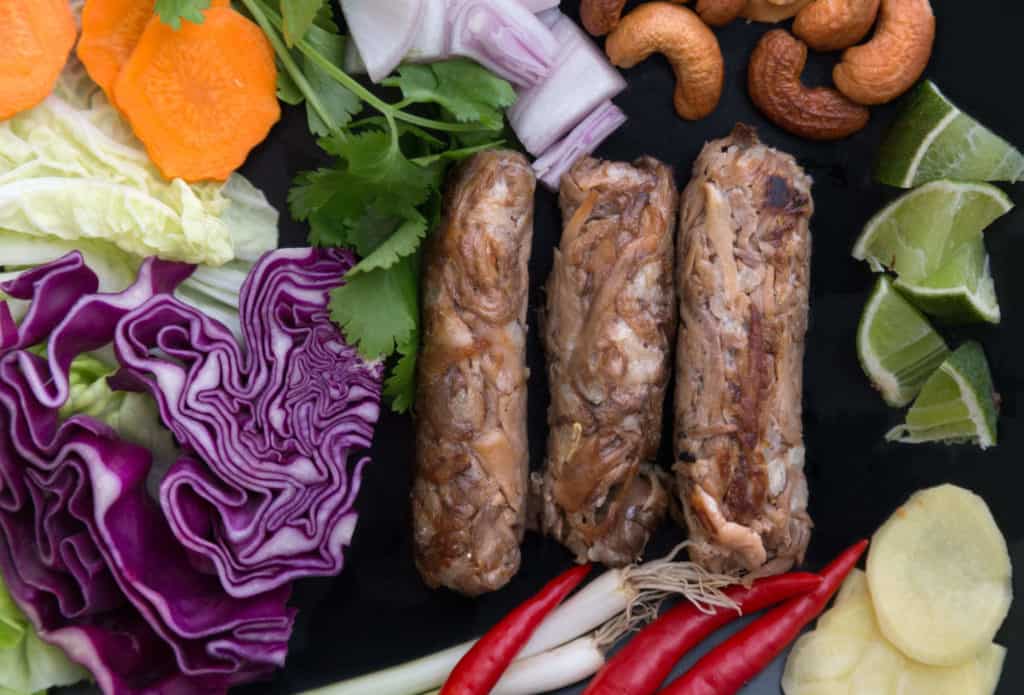I believe 2010 was the first year I visited Pun Pun, a highly regarded vegetarian restaurant in Thailand's Northern city of Chiang Mai (FYI in 2012 they used oyster sauce so if you visit it's worth asking if this is still the case). Two years later, after one bite of their fermented mushroom sausages, I plucked up the courage to beg admission to their kitchen. It was granted, and that's how I learned to make naem het (also written hed).

Naem is a preserved sausage of Northern and Northeastern origins composed of ground pork that is fermented with rice and garlic. Lactic acid generated by the fermentation process (fed by sugar and carbohydrates from rice), along with salt, inhibits growth of unwanted bacteria. What you end up with is a salty and sour sausage that is eaten in a myriad of ways – raw, grilled, deep fried, stir fried, in salads (e.g. yam naem hed khao tod), and more.
Naem hed borrows from the same basic method of fermentation, only with one major difference: this version is 100% vegan, made from mushrooms (het means mushroom in Thai – เห็ด) instead of pork. Mushrooms are shredded, steamed vigorously, wrung out, and then mixed with salt, rice, and garlic to ferment. Sometimes the mix is formed into cylindrical sausage shapes and other times bite sized portions are packed into small plastic baggies with a chilli inside.
Worth noting is the importance of spicy chillies in the preparation and consumption of these sausages. As well as acting as a preservation agent, chillies (along with ginger and plenty of raw vegetables as condiments) help to cut through the fattiness of the pork. Despite the lack of fat in the vegan mushroom based version, I have never come across them sans chilli (and if I have there are always bird's eyes served alongside). Personally I think the scuds are a must, but if you are averse to too much heat then you will still enjoy a very good meal if they are omitted.
These sausages will always ferment more successfully at higher temperatures (it's Thailand, after all) with moderate humidity.
In addition to bird's eye chillies, sliced ginger, and uncooked vegetables (especially cabbage), there are a few other ingredients you should consider adding to the plate in order to enhance this dish: raw shallots, fresh lime, roasted peanuts and/or deep fried cashews, and sprigs of coriander.
📖 Recipe
Naem Het (naem hed) แหนมเห็ด – vegan Thai fermented mushroom sausages
Ingredients
- 225 grams oyster mushrooms
- Scant ¼ teaspoon salt
- 1 large clove garlic
- 15 grams cooked glutinous rice
- Pinch of sugar
Instructions
- Before starting, ensure all utensils and bowls you use are scrupulously clean. Hands too!
- Cut or tear the oyster mushrooms lengthwise (down the lines of the gills) into thin slivers. Pile them into a steamer and steam for 20-30 minutes on a fairly high heat. They will be fine and stringy, but tough, when finished. Allow to cool enough to handle.
- While the mushrooms are cooling pound the salt and garlic to a fine paste with a pestle and mortar.
- Rinse the cooked rice to break up any clumps and squeeze or press it to remove excess water. Pop the rice into the mortar and pound lightly with the garlic paste. The goal isn't to make it into a paste, but to break the grains down only slightly.
- Once the steamed mushroom shreds have cooled you must rid them of excess moisture by wringing them out in muslin or another thin cloth. Pressing in small portions will make this easier. Wring as much liquid out as possible (tip: save the liquid and use as a replacement for vegetable stock in recipes).
- Combine the rice and garlic paste with the mushrooms in a bowl and knead with your hands to combine. Divide them into four portions and wrap them in squares of cling film to form small sausage shapes.
- Remember, these would be fermented at temperatures around or above 30 degrees Celsius in Thailand, so find a warm spot to leave them to ferment. In the winter I often wrap them in a tea towel and leave them under a radiator. Another option is an airing cupboard. In ideal conditions these could be done in 24 hours, but I find anywhere from 3-7 days is right in the English climate. They should taste salty, slightly sour, and pungent from garlic when done.
- You can eat them raw or fry them briefly, which is my preference because it imparts some oiliness that pairs well with the sides you should consume the sausages with: deep fried cashews and/or peanuts, raw cabbage, thinly sliced ginger, bird's eye chillies, chopped shallots, fresh lime, and sprigs of coriander.